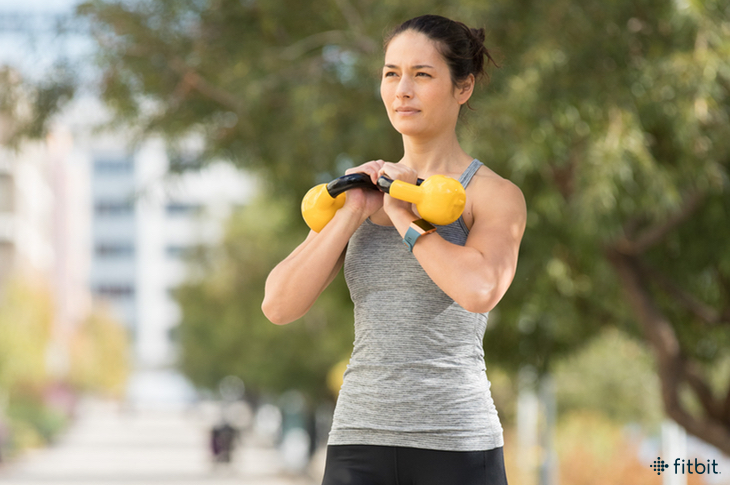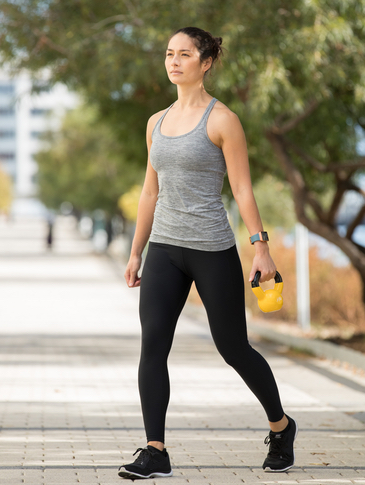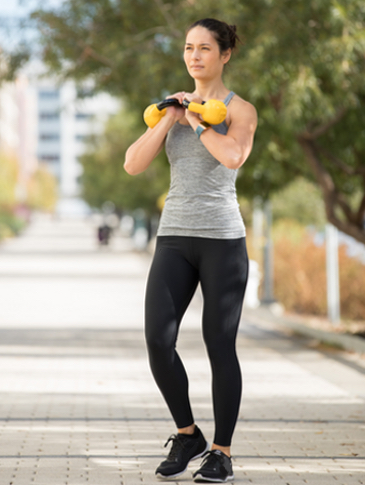
Walking allows you to get in your steps, flex your aerobic muscle, take in some fresh air, and even boost your brain health. But what if you added a bit of weight to your routine? Combining walking and strength training can be a great way to save time and sculpt sleek muscles, says Adrian Richardson, a workout curriculum designer and certified personal trainer for Fitbit Coach. The best part? Compound movements, like those done in this kettlebell routine, engage more than one muscle group at a time and mirror functional, everyday tasks, so you can accomplish your day-to-day tasks with ease.
Walk your way strong with these four, easy kettlebell movements. For each movement, remember form is key: Keep your back straight, shoulder blades pulled down and back, and core engaged. Start with a comfortable weight that allows you to move at a steady pace and maintain a short stride for increased overall stability. Integrate one or all of these movements into your regular walking routine to build strength.
1. Kettlebell Suitcase Carry

Overweight suitcases might cost you extra at the airport, but when it comes to fitness those added pounds can spell results. For these carries, use a kettlebell to train one side of your body at a time and build overall strength and coordination.
Directions:
- Find a kettlebell that’s about as heavy as a carry-on suitcase (about 30 pounds). Stand next to it, and using a deadlift stance (core tight, hips back, chest up), lift the kettlebell off the floor while keeping your back braced and glutes tight.
- With shoulders and hips level, walk forward 50 feet while keeping the “suitcase” glued to your side. Limit lateral movement.
- Switch arms and walk back to your starting position.
2. Kettlebell Farmer’s Walk

Schlepping bags of groceries becomes easier with practice, and nothing says practice like picking up two kettlebells and walking. You’ll strengthen your grip while engaging your entire body—from your upper back to your legs.
Directions:
- Pick up a pair of kettlebells, one in each hand, keeping your back flat and core engaged—the same way you would for a deadlift.
- Holding both kettlebells in the center of the handle, walk forward 50 feet.
- Turn, and repeat the farmer’s walk back to your starting position.
3. Overhead Kettlebell Walking Lunge

Walking lunges are great for targeting your posterior chain. Add in an upper-body challenge by pressing a single kettlebell overhead for added resistance. Keep your back straight and your knees in line with your ankles. When lunging, only lower as far as you can while maintaining control.
Directions:
- With your feet shoulder-width apart and knees slightly bent, squat down, and lift a kettlebell up to your chest with your left hand. Pushing through your heels, return to standing and press the kettlebell overhead. Keep the weight in line with your shoulder joint and your arm close to your ear.
- Step forward with your right foot, keeping your weight in the heel of your front foot while lowering your back knee towards the ground. Be sure not to lean to one side; keep your core tight and shoulders down and back.
- With your back knee hovering above the ground and the kettlebell still pressed overhead, push off your back foot and step forward to bring your feet back together. “Walk” your lunge forward 50 feet, alternating legs.
- Lower the kettlebell to your chest, turn around, switch arms, and return to your starting position.
4. Kettlebell Rack Walk

Walking works your lower body, but incorporating kettlebell rack walks into your routine can increase upper-body strength. Aim to keep your elbows low and close to your ribcage and your hands close together. These walks can get difficult fast, so use lighter kettlebells than you did in the exercises above.
Directions:
- Clean (or lift) two kettlebells into the rack position*, meaning your forearms are vertical and wrists neutral (rather than bent back and putting pressure on your elbow and shoulder).
- Stand tall with the kettlebells pulled in tight. Keeping your shoulders level and core tight, walk forward 50 feet.
- Turn and do the same rack walk back to your starting position.
*If you’re new to this movement, try a single-arm variation: Grab one kettlebell and lift it to shoulder level, keeping your arm glued to your side; the kettlebell should rest between your bicep and forearm. Keeping your hand near your shoulder and your wrist straight, walk 50 feet. Turn, switch arms, and rack walk back to your starting position.
This information is for educational purposes only and is not intended as a substitute for medical diagnosis or treatment. You should not use this information to diagnose or treat a health problem or condition. Always check with your doctor before changing your diet, altering your sleep habits, taking supplements, or starting a new fitness routine.

I just started back walking again. I read your article and I am planning to do a variation of it. I don’t have kettle balls but I do have 2.5, 5, 7.5 and 10 pound weights. If I start off walking with 2.5 for 3 miles, then move up in weight, It can’t hurt, at least that is my thought.
I find that the Kettlebell Bottoms Up is a great walking exercise that helps improve balance and mobility. It scales nicely depending on the size weight you are working with